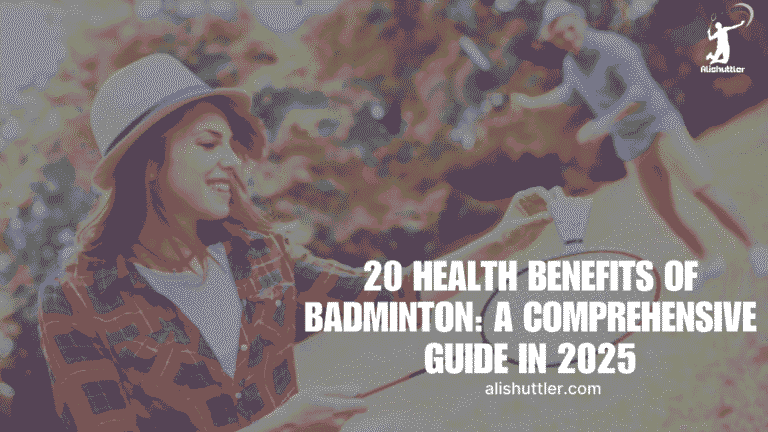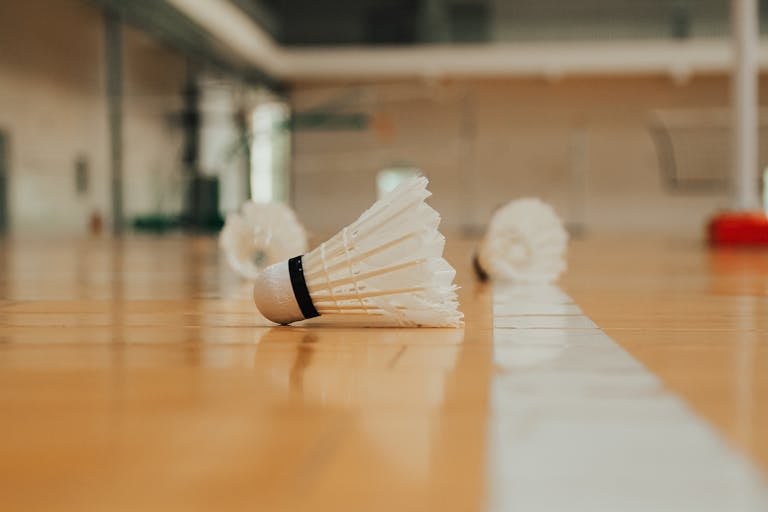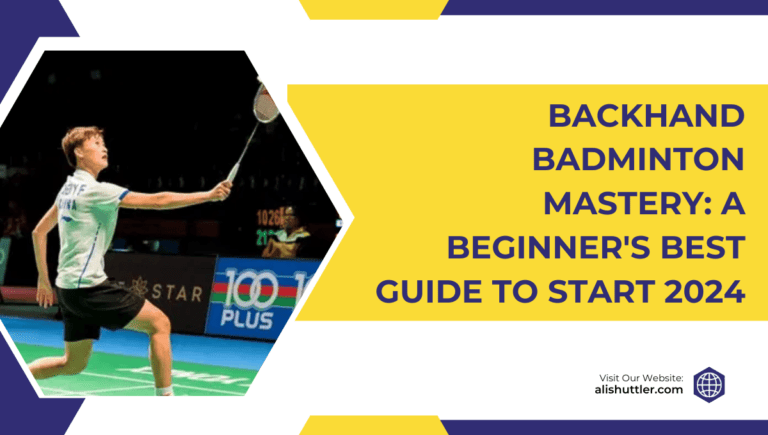A badminton net is an important piece of sports equipment. It divides the court into two equal sides and establishes the limits of the playable area.
In the United States, most nets used for doubles play are approximately 5′ high at the centre. Once set up, they are 20 feet wide, indoors or outdoors.
The mesh is tight enough to prevent the shuttle from passing through but still light enough not to obstruct the view. Nets installed at public parks or school yards are typically made of nylon or polyester, which provides some additional durability and weather resistance.
Some nets include simple clip-on posts for quick assembly, whereas others are integrated into permanent courts. Knowing the right net size and setup makes games fair and simple for anyone starting a backyard game or playing league matches.
Badminton Net: The Official Lowdown

A regulation badminton net is more than just a simple barrier. It continues to be the muscle behind good sportsmanship and uniformity across the badminton court. The net’s construction, installation, and composition all contribute to how the game plays and the pacing of the game.
Let’s take a closer look at the usual components and why they’re important for each and every game.
1. Height: The Non-Negotiable
Official net height is crucial. The net should be 1.55 meters (5 feet 1 inch) high at the post. It must curve down to 1.524 meters (5 feet) in the middle. This holds for singles as well as doubles.
When the net is too high, clears and smashes become less exciting. Too high, we fall into net shots being way too easy. Make sure to measure with a tape measure to ensure both ends and the center measure correctly.
While installing, make sure to modify post height or tension accordingly to prevent any shifts in measurement.
2. Length & Width Standards
Professional badminton nets are 6.1 meters (20 feet) wide to fit perfectly across the full width of the court. Their length is between 6.02 and 6.10 meters. The width of the net doesn’t change regardless of being in singles or doubles.
These dimensions are critical to making sure the net is tight enough to touch the court lines, eliminating some of those crazy ricochets. Other sports use different net sizes—see below:
| Sport | Width (ft) | Height (ft) |
|---|---|---|
| Badminton | 20 | 5.1/5.0 |
| Tennis | 42 | 3.5/3.0 |
| Volleyball | 29.5 | 7.97 |
3. Net Materials: From Nylon to PE
For strength and flexibility, most regulation nets are made with nylon blends. Most portable nets are made of polyethylene (PE) because it holds up sturdily against the wear and tear of the great outdoors.
Durability is a key factor. Nylon is more durable for indoor play, but PE would be good for a park or backyard. Both require regular inspections for fraying to ensure safe play.
4. Mesh Size: Why It Matters
In the case of a regulation mesh, it cannot be more than 2.5 centimeters (1 inch). This dense mesh prevents the shuttlecock from going through. It helps to make sure rallies are continuous and smooth, plus it provides airflow to avoid the shuttle getting affected.
When choosing a net, choose mesh that is taut but not rigid. Key points include:
- Mesh must be small enough for shuttlecock containment
- Good airflow boosts game speed
- Check for sturdy, even mesh
5. Top Tape: The Finishing Touch
The net’s top tape, at least 7 centimeters (2.75 inches) wide, runs along the entire top and sides. It keeps the net from getting out of place and prevents any fraying.
Cotton and synthetic tapes are ideal—they improve racquet grip and decrease tape wear, prolonging net life. Good, strong tape also translates to fewer mid-game fixes.
6. Net Tension: A Game Changer
Tight nets stay flat and keep the shuttle from bobbling in the air. Higher tension nets make for a more even playing field. Increasing net tension is as simple as pulling on the cords or tweaking the corner posts before a game.
Correct tension should leave the top band straight but not pulled too tight. For upkeep, remember to:
- Check before each match
- Tighten or loosen as needed
- Replace worn cords
Net Secrets: Beyond Specifications

Badminton nets act as a curtain, blocking distractions from hitting your mind like an errant shuttlecock. The construction of a net also greatly affects the feel of the game, as well as players’ movement and reactions. Everyone’s aware that a volleyball net is 1.55 meters high at the sides.
While most people know that superb tennis court dimensions sink to 1.52 meters at the middle, less know how vital these figures are for equal play and effective rallies. The mesh, which is 2’6” long, can only have a minimal amount of droop or tension in order to maintain the same length on each side. When these specs are adhered to, competitive player performance remains crisp and equitable.
These three lesser-known features have made my life much easier. For instance, the mesh weave and tie-off strength contribute to a net being easier to string and then maintaining its tension throughout a long match.
Look for nets with reinforced edges or weatherproof coatings, as these features can go a long way in improving longevity and usability. By knowing what these design decisions mean, players are better equipped to choose a net appropriate for them. This increases their confidence to play.
Net quality impacts more than just the appearance of the court. A taut, even netting ensures that every shot is a clean one. Weak or sagging nets reduce the speed of shuttlecock flight and result in shoddy, uneven play.
For competitive players who seek long, flowing rallies, learning how nets are produced can make the difference between an enjoyable experience and a high level of frustration.
Shuttlecock Flight: Material’s Role
Shuttlecock flight—Material’s influence Native American and Indigenous Writers and Artists, Leaders, Activists. Nylon nets, which are standard in many U.S. Gyms, provide consistent tension and a clean rebound. Although cotton nets are softer, they can slow the shuttlecock.
Elasticity is important as well—an elastic net that has just the right amount of play maintains the shuttlecock’s velocity following a hit. To perform well, choose a nylon or polyester blend with a close, consistent mesh.
In competitive play, these nets allow for the shuttlecock to rebound smoothly allowing for faster-paced, more dynamic rallies.
Weather’s Impact on Your Net
Impact of weather on your net Outdoor nets are constantly exposed to wind, rain, and sun. Sun can quickly degrade cotton fibers, and heavy rain can leave cheap nylon brittle. In extreme environments, polyester nets will outlast nylon.
Keeping nets indoors during storms will protect them from the growth of mold or warping.
Tips for net care:
- Dry nets before storing
- Use covers for outdoor courts
- Check tension after bad weather
- Replace frayed mesh quickly
Indoor vs. Outdoor Net Designs
Indoor vs outdoor net designs Indoor nets are primarily designed for stability and even tension, often using a heavier mesh with reinforced tie-offs. Outdoor nets may include UV coatings and a lighter mesh for wind resistance.
Pick reinforced nylon or polyester for use in parks and backyards, and thicker mesh for indoor gyms. Choosing the appropriate net for your environment creates a safer, more enjoyable experience with less maintenance.
Mesh Elasticity: Play Feel
Mesh elasticity affects how the shuttlecock bounces off the net. Too tight, and shots perish. Too loose, and rebounds go crazy. Most players prefer nylon mesh with slight give—enough to absorb speed but firm for control.
In competitive league matches, nets with consistent mesh elasticity provide equitable bounce and assist in maintaining clean rallies.
Pick Your Perfect Portable Net
Choosing the best portable badminton net involves understanding its role as a central gameplay element.
Features to Consider
It’s more than just the net itself. It’s all about how it works in your space, what fits your style, and how much you’re going to play! A portable net is the perfect answer for large, outdoor games in L.A. All across the country, providing you quick, easy setups without any extra tools needed.
Most models compact down to a small size and weigh just 0.41 pounds. So you can easily take them to local parks, beaches, or a friend’s backyard! Some even include LED shuttlecock or multi-sport usage, transitioning from badminton to volleyball or pickleball in a blink.
Portability is a big deal if you’re playing in big city parks or small urban backyards. Here’s what to keep in mind:
- Weight and carrying case
- Net dimensions (standard is 20 feet wide)
- Material and frame strength
- Stability in windy spots
- Setup speed and instructions
Portability: Play Anywhere, Anytime
Lightweight nets with collapsible or foldable frames are easy to store and transport. Compact carrying cases easily fit in car trunks or bike baskets. Features such as click-together poles and tangle-free nets assist in speeding up setup time.
Popular choices—such as the Boulder Portable Net or Zume Games Combo Set—illustrate that fast game play is not only convenient but can be done in smaller areas.
Durability: Investing Wisely
Look for steel or heavy-duty plastic frames, and thick netting. Inspect seams and net edges for fraying and ensure that all poles lock securely. A durable net may have a higher initial cost, but it will last longer and remain safe for family or group use.
Checklist:
- Inspect net mesh and seams
- Test frame for sturdiness
- Check for rust-proof parts
Setup Ease: Get Playing Faster
Clear assembly instructions, color-coded poles, and snap-on connectors make it easy to get set up quickly. Do your best not to force any poles or skip steps. Most nets set up in under five minutes:
Step-by-step:
- Lay out net and parts.
- Connect base frames.
- Attach uprights.
- Hang net evenly.
- Secure and check tension.
Fixed vs. Portable: Safety & Fairness
Fixed nets are permanent structures that do not move, allowing them to be robust and equitable for competitions. While portable nets are easily movable, they require a little more attention to ensure stability, particularly on rocky terrain or grass.
Portable nets take the cake for casual games and pick-up matches… for a reason! If you plan to set up your net for league-level matches, fixed nets provide greater stability.
2024’s Top 10 Portable Nets

Portable badminton nets make it easy to take fun to almost any location—whether that’s a park, backyard, beach, or even a driveway. In 2024, the top portable nets really shine with their fast setup, thoughtful design, and multiple use capability.
Our list highlights nets that handle real-world needs: speed, quality, price, and adaptability.
Our Selection Process Explained
To choose these nets, we considered real-world performance tests, user feedback, and expert analysis. Ease of setup was a priority, focusing on nets that set up in under 10 minutes.
Second, they had to score high on durability and work in multiple settings. Experience from hundreds of buyers and coaches aided in the identification of nets that hold up, and ones that make for an enjoyable net experience.
We evaluated how long they lasted outdoors. We focused on keeping the court lines simple, so it was especially important that each net be portable enough for quick setups.
Top All-Around Portable Net
The top all-around portable net features a lightweight, knotless design that adapts to indoor or outdoor games. Its durable material prevents corrosion while its adjustable height allows you to go from badminton to volleyball or tennis.
We had both casual and league players alike test it out, all of whom dug its slick net tension and obvious center tape. Notable specs include a 10-foot width, 5-foot height, and a carry bag.
Best Budget-Friendly Option
Our budget pick is less than $25. It’s basic, but well-built, with solid posts and a durable mesh that’s not going to sag out quickly.
That’s the trade-off—lighter frame material, but nearly all customers agreed it stood up to the carnage of backyard rallies. That said, it’s a great match for families or beginners.
Quickest Setup Net
The fastest net to assemble, this one snaps together in under five minutes. Their click-lock frame and fold-out base minimize setup hassle.
Players reported this net allows them to play more and repair less.
Most Durable Portable Choice
Designed for rough use, this heavy-duty net features steel poles and weather-resistant nylon mesh. Included with the net is a two-year warranty.
Users loved its reliability in club practice and on windy days.
| Net Name | Setup Time | Weight | Knotless | Price |
|---|---|---|---|---|
| All-Around Net | 7 min | 10 lbs | Yes | $55 |
| Budget Option | 9 min | 8 lbs | No | $23 |
| Quickest Setup | 5 min | 9 lbs | Yes | $39 |
| Most Durable | 8 min | 13 lbs | Yes | $79 |
| … | … | … | … | … |
Keep Your Net Game Strong

Caring for your badminton net Preventive maintenance will make your net perform at its best and last longer. It maintains your game net sharp, keeping you ready to identify weak areas on the court and finesse those killer spins. Without consistent maintenance, nets may sag, fray, or rupture. This is enough to trip up even the most killer serve or return.
Because of this, it’s very difficult to simulate the quick, deceptive net plays that occur in a match! Even small actions can make a big difference. Here are some basics:
- Check for loose knots or frayed cords
- Wipe down after each session with a damp cloth
- Dry fully before packing away
- Store out of direct sunlight
- Tighten the net when it starts to sag
Smart Net Storage Tips
Smart net storage tips Storing your net properly is important. Store it dry and rolled up, not folded to prevent kinks. Smart storage solutions A zippered nylon bag or hard case works well for portable nets.
That’s particularly the case if you play at public parks or gyms across Los Angeles. If you are storing it for a long time, store the net in a cool, dry location. NEVER store it outside during the rainy winter or in a hot garage!
Cleaning Your Badminton Net
For nylon or polyester nets, use a mild soap and water solution. We recommend steering clear of strong chemicals. Scrub gently, rinse thoroughly, and air dry completely before packing.
Clean nets allow for crisper play, helping you really dial in your spins, serves, and returns to perfection.
Retensioning for Peak Performance
Don’t let a loose net kill the excitement of a great rally. To check tension, press the top cord with finger. It should spring back into place. If it isn’t, retension it to the proper tension.
Indicators such as sagging or inconsistent height are a sign that it’s time to retension. With smooth, consistent tension, you’ll find the net shots falling perfectly in place.
Spotting Damage Early
Look for rip, frays, broken cords or knots. Routine inspections identify minor damage before it has a chance to worsen. Use this quick list: look for frays, check knots, test cord stretch, and scan for holes.
Repairing these early prevents more serious issues and helps avoid disruption to your practice.
The Future of Badminton Nets

The future of badminton nets is bright. In recent years, manufacturers have moved toward more durable, longer-lasting nets that can withstand the elements. Lighter frames, tighter mesh, and new design quirks have enabled players to easily rig up matches just about anywhere.
That emphasis on designing for real-world use is driving the way nets are designed, and what materials they’re constructed from. It makes sure they’re simple to use and maintain for clubs, schools and backyard players as well.
New Materials on the Horizon
An increased focus on materials is creating safer, smarter infrastructure. Today’s tech nets are pushing past just nylon. Manufacturers today consider combinations that combine durability with pliability, such as polyester woven with weather-resistant coatings.
These modifications make nets more durable on outdoor courts and withstand greater abuse from everyday play. In addition to netting technologies, companies such as Yonex and Victor are experimenting with different weaves and coatings to prevent nets from sagging or fraying.
Another area of research is into UV-resistant fibers, which prevent nets from fading or degrading in sunlight. For players, that translates into fewer interruptions and a net that remains taut and standing tall for longer periods of time.
How Player Input Drives Change
Players have an actual, tangible impact on the production of new nets. Many times, brands will send out extensive surveys and/or create local pilot programs with local clubs to test what works and what doesn’t.
It’s a common theme among players that they would prefer nets that are easier to assemble and disassemble. In turn, manufacturers have introduced lighter posts and snap-together frames.
Concealed height-adjustable badminton nets have become increasingly popular, allowing players to adjust the net to accommodate different sports or skill levels. Sometimes, feedback results in adjustments to the net’s mesh size or how it attaches to the court.
Manufacturing Quality & Challenges
Creating high-quality badminton nets is not an easy task. Makers have to meet very tight tolerances for dimensions, such as the 20-foot width mandated by the sport’s regulations. They specifically test for things such as tear strength and weather resistance.
Each badminton net is subjected to several quality control tests to root out weak points or bad seams. With quality control being paramount since any defect can impact the way the game plays, most brands utilize double stitching and reinforced seams.
While the demand for less-setup-required nets generally leads to more portable frames, they still need to withstand the rigors of rough-and-tumble action.
Safety Engineering in Nets
After all, safety can’t be the thing that gets shortchanged. The most common dangers involving nets are loose cables and sharp edges, particularly in busy gyms or public parks.
To prevent tripping or injury, net makers have incorporated padded cable sleeves, smooth post caps, and heavy anchors. Other brands have started incorporating soft, flexible mesh along the sides to reduce abrasions.
These innovations contribute to creating safer playing environments for youths and adults alike.
Conclusion
A badminton net can definitely make or break your game, no kidding. The correct one stands up, stays taut, and endures beyond a few weekends of backyard play. Whether you’re playing in your garage, a community recreation center, or during a family picnic, a quality net is the key to great gameplay. That translates to more enjoyment and less hassle! Brands are constantly innovating—lighter frames, easier/quick set-ups, more durable mesh—so you’ll never be left playing with someone’s old saggy net from years ago.
Ever seen people tape broomsticks together to hold a net? Not at all with today’s selections! Looking to catch one of 2024’s top prospects? You, dear reader, should do the same. Take the challenge and experience how much better matches can be with a net designed specifically for your location. Please give it a go, share your gameplay, and rally on together.
Frequently Asked Questions
What is the official height of a badminton net in the U.S.?
A regulation badminton net, which is a central gameplay element, stands 5 feet tall in the middle and 5 ft. 1 in., adhering to USA Badminton rules for recreational and competitive play alike.
Can I use a portable badminton net indoors and outdoors?
Can I use a portable badminton net outdoors and indoors? For outdoor use in Los Angeles or other sunny climates, choose weather-resistant materials to ensure the badminton nets maintain their integrity.
How do I choose the best portable badminton net for my backyard?
Choose a portable badminton net that’s durable and simple to assemble, ensuring it works well with your indoor or outdoor badminton court. A stable base and adjustable height are crucial features for Southern California backyards with uneven surfaces.
What material should I look for in a high-quality badminton net?
Look for badminton nets constructed from nylon or polyethylene with stitched edges. Both of these materials are very resistant to sun damage and stand up to wear, making them ideal for outdoor play on a badminton court in Los Angeles.
How do I maintain my badminton net in good condition?
To maintain its quality, keep your badminton net indoors when not in use, especially during extreme weather conditions. Properly store your badminton nets away from direct sunlight to prolong their life, and clean them with mild soap and water only.
Are there official portable nets recommended for tournaments in the U.S.?
Are there official portable badminton nets recommended for tournaments in the U.S.? Look for official certification and approval. If you’re hosting or competing in regulated competitive events, the badminton net should be a recognized standard.
What are the benefits of using a portable badminton net?
Portable badminton nets are incredibly lightweight and simple to set up, making them perfect for creating a badminton court just about anywhere. They are ideal for parks, beaches, and backyard games, especially popular in active cities such as Los Angeles.






